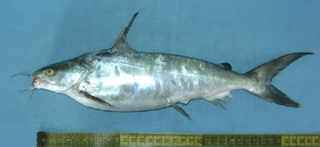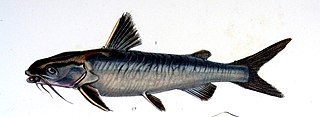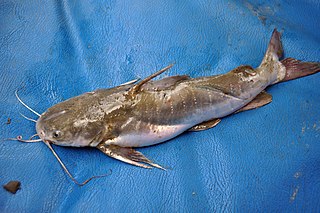
The giant catfish, also known as the giant sea catfish, giant salmon catfish, giant marine-catfish, or the khagga, is a species of catfish in the family Ariidae. It was described by Eduard Rüppell in 1837, originally under the genus Bagrus. It inhabits estuaries and occasionally freshwater bodies, in Japan, Australia, Polynesia, southern Vietnam in the Mekong Delta, the Red Sea and the northwestern Indian Ocean. It dwells at a depth range of 10 to 195 m. It reaches a maximum total length of 185 cm (73 in), but usually reaches a TL of 70 cm (28 in).

Genidens barbus, the white sea catfish or marine catfish, is a species of catfish in the family Ariidae. It was described by Bernard Germain de Lacépède in 1803, originally under the genus Pimelodus. It is an oceanodromous species that is found between the mouth of Negro River in Patagonia and eastern Brazil. It reaches a maximum total length of 120 cm (47 in). It has been recorded spawning between the months of August–December. The maximum known life expectancy is 36 years.
The spotted sea catfish, also known as the spotted catfish, the sea barbel or the marine catfish, is a species of sea catfish in the family Ariidae. It was described by Carl Peter Thunberg in 1792, originally under the genus Silurus. It inhabits tropical marine, brackish and freshwater in the Indo-western Pacific region, including Bangladesh, India, Pakistan, Myanmar and Sri Lanka. It dwells at a depth range of 50 to 100 m. It reaches a maximum total length of 80 cm (31 in), more commonly reaching a TL of 30 cm (12 in).

The shovelnose sea catfish, also called the short-nosed catfish or the marine catfish, is a species of sea catfish in the family Ariidae. It was described by Achille Valenciennes in 1840.
The comb-gilled catfish is a species of sea catfish in the family Ariidae. It was described by Albert William Herre in 1935, originally under the genus Arius. It is a tropical freshwater fish which is found in Papua New Guinea. It reaches a maximum standard length of 30 cm (12 in).
The hard-palate catfish, also known as the hard-plate catfish, is a species of sea catfish in the family Ariidae. It was described by Albert William Herre in 1935, originally under the genus Arius. It is a tropical freshwater fish which is found in Indonesia and Papua New Guinea. It reaches a maximum standard length of 60 cm (24 in), with both sexes more commonly reaching an SL of 35 cm (14 in). It reaches a maximum weight of 1.8 kg (4.0 lb).

Neoarius graeffei, or blue salmon catfish, is a species of catfish found in freshwater rivers of Australia and Papua New Guinea. This species is most identifiable by its large, shark-like dorsal fin that is led by a poisonous spine. Like other catfish, the blue salmon catfish is known to use electrical pulses to sense prey in the water. This prey sensing mechanism may be the reason that these catfish are known to eat the land dwelling hopping mouse at a high rate.

Genidens genidens, the Guri sea catfish or marine catfish, is a species of catfish in the family Ariidae. It was described by Georges Cuvier in 1829, originally under the genus Pimelodus. It is known from southern South American rivers connected to the Atlantic Ocean. It is known to reach a total length of 42.5 cm (16.7 in), but more commonly reaches a TL of 35 cm (14 in). It has been recorded spawning between Autumn and Spring. Its diet includes polychaete worms, plants, finfish, mollusks, and benthic crustaceans.

Hexanematichthys sagor, the Sagor catfish, Sagor sea catfish, Sunda sea-catfish, marine catfish or dusky catfish, is a species of catfish in the family Ariidae. It was described by Francis Buchanan-Hamilton in 1822, originally under the genus Pimelodus. It inhabits estuaries and freshwater bodies in numerous areas of the Indo-Western Pacific ocean. It reaches a maximum total length of 45 cm (18 in), more commonly reaching a TL of 30 cm (12 in).
Neoarius leptaspis, the salmon catfish, boofhead catfish, freshwater forked tailed catfish, lesser salmon catfish, or triangular shield catfish, is a species of catfish in the family Ariidae. It was described by Pieter Bleeker in 1862, originally under the genus Hexanematichthys. It inhabits marine, brackish and freshwaters in Australia and New Guinea, at a maximum known depth of 135 m (443 ft). It reaches a maximum standard length of 60 cm (24 in).
Neoarius coatesi, or Coates' catfish, is a species of catfish in the family Ariidae. It was described by Patricia J. Kailola in 1990, originally under the genus Arius. It is endemic to Papua New Guinea, being only known from the Sepik and Ramu Rivers. It reaches a maximum standard length of 75 cm (30 in), more commonly reaching an SL of 45 cm (18 in). Its maximum known weight is 5 kg (11 lb).
Neoarius latirostris, the broad-snouted catfish, is a species of catfish in the family Ariidae. It was described by William John Macleay in 1883, originally under the genus Arius. It inhabits freshwater rivers in Indonesia and Papua New Guinea. Its diet includes finfish, mollusks, prawns, terrestrial arthropods, aquatic insects, and plants. It reaches a maximum standard length of 50 cm (20 in).
Neoarius midgleyi, the silver cobbler, Lake Argyle catfish, Lake Argyle silver cobbler, Midgley's catfish, Ord River catfish, shovel-nosed catfish, or shovelhead catfish, is a species of catfish in the family Ariidae. It was described by Patricia J. Kailola and Bryan E. Pierce in 1988, originally under the genus Arius. It inhabits brackish and freshwaters in northern Australia. It is known to reach a maximum standard length of 140 cm (55 in), but usually reaches an SL of 50 cm (20 in).
Neoarius pectoralis, the sawspine catfish or sawspined catfish, is a species of catfish in the family Ariidae. It was described by Patricia J. Kailola in 2000, originally under the genus Arius. It inhabits marine and brackish waters in Australia, Irian Jaya, and possibly also Papua New Guinea. It reaches a maximum fork length of 39.3 cm (15.5 in).
Neoarius utarus, the northern rivers catfish or salmon catfish, is a species of catfish in the family Ariidae. It was described by Patricia J. Kailola in 1990, originally under the genus Arius. It inhabits freshwater bodies in Indonesia and Papua New Guinea.
The Thomas sea catfish is a species of catfish in the family Ariidae. It was described by Achille Valenciennes in 1840, originally under the genus Arius. It inhabits mud on the floors of brackish and marine waters between the Gulf of Venezuela and the Amazon River, at a depth range of 1 to 20 m. It reaches a maximum total length of 63 cm (25 in), more commonly reaching a TL of 40 cm (16 in).
The longsnouted catfish, also known as the Broadbent's catfish, the spoon-nosed catfish, the large-scaled catfish, the sharp-headed catfish, or the sand catfish, is a species of catfish in the family Ariidae. It was described by Achille Valenciennes in 1840, originally under the genus Arius. It inhabits brackish and marine waters in New Guinea, Australia, and southern and southeastern Asia. It reaches a maximum total length of 50 cm (20 in).

The Pemecou sea catfish, also known as the flapnose sea catfish, the mud cuirass, or the gillbacker, is a species of catfish in the family Ariidae. It was described by Marcus Elieser Bloch in 1794, originally under the genus Silurus. It inhabits marine, brackish and freshwaters in Brazil, Guyana, French Guiana, Colombia, Suriname, Venezuela, and Trinidad and Tobago. It dwells at a depth range of 1 to 5 m. It reaches a maximum total length of 94.2 cm (37.1 in), while males more commonly reach a TL of 30 cm (12 in) and females reach a TL of 62.5 cm (24.6 in). It reaches a maximum weight of 1.5 kg (3.3 lb).
Sciades paucus is a species of catfish in the family Ariidae. It was described by Patricia J. Kailola in 2000, originally under the genus Arius. It inhabits freshwaters in Australia. It reaches a maximum total length of 130 cm (51 in), and a maximum weight of 2.8 kg (6.2 lb).
The crucifix sea catfish — also known as the Christfish, the crucifix/crucifex catfish, the crucifixfish, or the gillbacker, — is a species of catfish in the family Ariidae.






